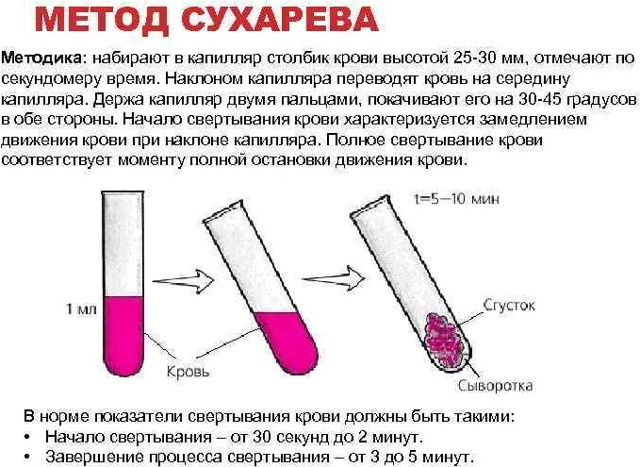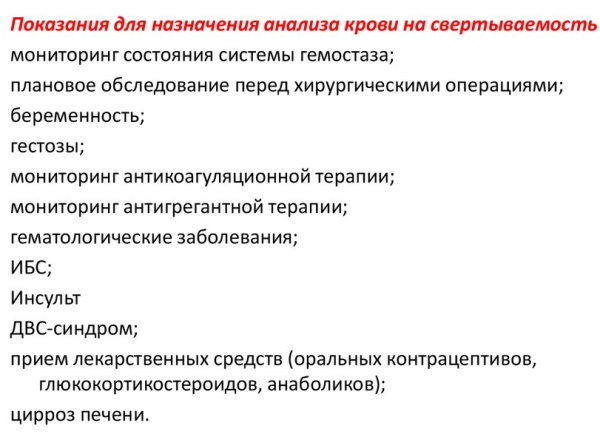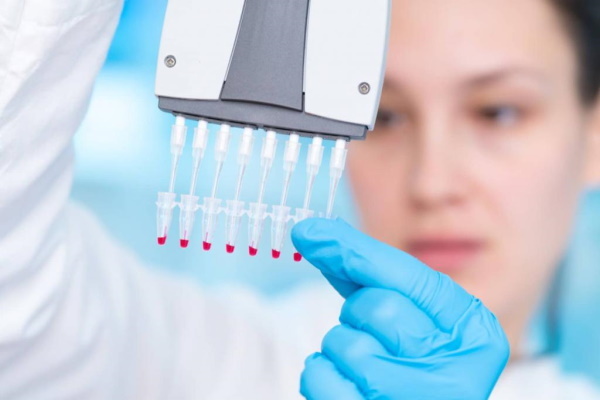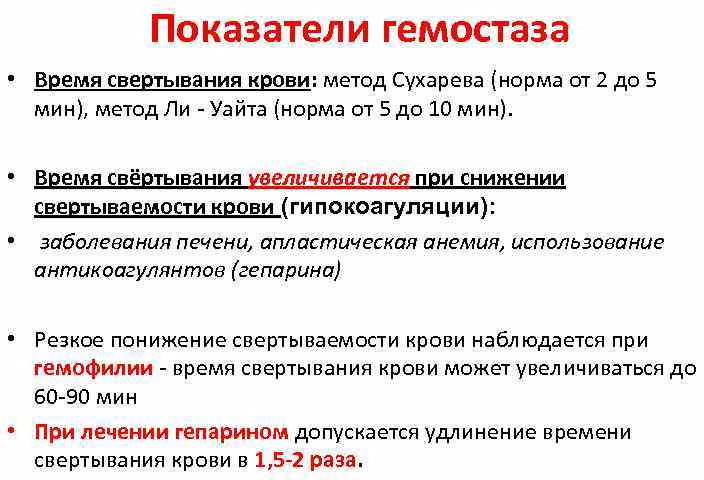Content
- Why determine the rate of blood coagulation, what does this indicator mean?
- What is the essence of Sukharev's method?
- Indications for the analysis
- Factors affecting the test result
- Test preparation
- Features of the study
- Sukharev blood coagulation time norms in children, adults and pregnant women
- Possible reasons for the deviation of the analysis indicators from the norm
- Decreasing parameters
- Increasing parameters
- Research cost
- Video about a blood test according to Sukharev
Before surgery, a blood clotting test is prescribed to monitor the progress of pregnancy. A laboratory test determines the norm or deviation from the standard indicator of the concentration of enzymes and fibrin. Research by the Sukharev method involves the use of capillary biological material.
Why determine the rate of blood coagulation, what does this indicator mean?
A coagulogram is important for assessing the state of hemostasis. This functional system is an evolutionarily developed defense reaction of the body aimed at preventing lethal blood loss in case of vascular damage.
Hemostasis is a sequence of physiological processes that provide sufficient for normal vital activity the volume of hematological fluid and its maintenance in the optimal aggregate condition.
Blood coagulability according to Sukharev (the norm is estimated as the time interval between the sampling of biological material and the beginning of its thickening) is determined for:
- making a diagnosis;
- clarification of the clinical picture;
- many other therapeutic purposes.
The coagulation mechanism is associated with physiological reactions and the chemical composition of the molecular plasma fraction of the hematological fluid. The leading role in the process of blood coagulation is assigned to fibrinogen - a colorless protein contained in the blood, which is cleaved by thrombin.
The process is automatically activated when the vascular walls are damaged. As a result, fibrin is formed - a high-molecular-weight protein compound of a non-globular type. The substance is the finest insoluble filamentous structures that form a dense network.
The complex of biological transformations is aimed at the formation of clotting blood clots. They have a compacted structure that stops bleeding and heals wounds. The more platelets the material collected for laboratory analysis contains, the higher the coagulability of the hematological fluid.
Such diagnostic information characterizes the functional state of the hematopoietic system and requires:
- before operations;
- in the treatment of numerous diseases;
- to control gestation.
What is the essence of Sukharev's method?
Coagulogram is a preventive measure to prevent complications with an increased risk of massive blood loss or thrombosis when prescribing drugs that affect the rheological properties of the hematological fluid.

Sukharev's test involves the use of capillary biological material obtained by piercing the skin of the terminal phalanx of the finger with a scarifier.
The blood is placed in a laboratory vessel, alternately tilting it in opposite directions at an angle of 40 °. Simultaneously with the start of the hematological test, a stopwatch is started, which counts down the time until the biomaterial coagulates.
The analysis is considered extremely simple, well-developed and ubiquitous. It allows you to get an informative hemostatic picture of the time interval of coagulation.
The test does not determine the chemical composition of blood, does not provide data on physiological reactions. The main advantages of such an analysis are speed, simplicity and availability in any laboratory.
The vessel is tilted in a given monotonous rhythm without sudden movements and shaking the contents of the test tube. According to Sukharev's technique, the beginning of coagulation is considered to be the cessation of the free movement of biological material inside the vessel.
To automate the process, a special apparatus called Panchenko's tripod is used. The first drop of blood released from the finger is blotted out, since it contains particles of the epidermis that distort the measurement result. The rheological properties of the next portions of the biological material are studied.
Blood coagulability according to Sukharev (the norm is determined at the beginning of the process of formation of fibrin protein) is necessary:
- to assess the effectiveness of therapy;
- with injuries;
- with hemodynamic disorders;
- with hepatobiliary dysfunctions - fibrin is produced by liver cells.
The indicator plays an important role in the interpretation of the coagulogram by the attending physician. The clotting time according to the Sukharev method is used to predict ischemic conditions, the risk of heart attack or stroke.
Indications for the analysis
The time interval for blood coagulation is determined in preparation for surgery on the internal organs.
The following pathologies are considered indications for a hematological test:
- drug, chemical or alcoholic intoxication of the liver;
- hepatitis;
- cirrhosis;
- stomach ulcer;
- gastritis;
- erosive and perforating processes in the intestine;
- varicose deformity of the venous channels;
- tendency to thrombosis;
- diabetes;
- endocrine disorders;
- metabolic and metabolic disorders.
Such a study is prescribed before the use of anticoagulant drugs.
Determination of blood clotting is indicated for women:
- With menstrual irregularities. The test is prescribed as part of a differential diagnosis.
- Before giving birth. Diagnostic information about the rheological properties of blood avoids numerous complications.
- For artificial termination of pregnancy. Surgical intervention is traumatic and associated with massive blood loss.
- Before a cesarean section. Determination of hemostatic characteristics plays a significant role in ensuring the safety of the mother and child.
- With hypermenorrhea. Dysfunctional and pathological uterine bleeding needs clarification of the cause and the choice of adequate therapy tactics. A coagulogram according to Sukharev's method is carried out as part of a comprehensive laboratory-hardware diagnosis.
- In preparation for artificial conception. Hemostatic disorders can provoke bleeding during in vitro fertilization, during embryogenesis, and subsequent labor. Excessive thrombus formation causes blockage of blood vessels in the placenta, which leads to fetal death and miscarriage.
Coagulogram according to Sukharev's method is used in the selection of oral contraceptives, many of which affect the rheological properties of blood. The study is indicated for patients taking Heparin for a long time.
A hematological test is performed to clarify the clinical picture of DIC-syndrome - a pathological process with nonspecific physiological characteristics, which is characterized by the formation of disseminated blood clots. Among the numerous indications for a laboratory study of blood clotting time are autoimmune diseases, cardiovascular dysfunctions, and genetic pathologies.
The test is carried out if an excessive viscosity of the hematological fluid is suspected, due to an excessive concentration of fibrin protein or increased secretion of platelets. A coagulogram is prescribed for a comprehensive examination of patients prone to spontaneous nosebleeds.
Factors affecting the test result
During an active menstrual cycle, slight deviations from the standard are observed. Among the physiological factors influencing the result of the hematological test, the gestation period is distinguished. Hormonal changes in the body change the rheological properties of the blood.
Coagulability according to the Sukharev method distorts the intake of oral contraceptives. Small deviations from the established norm are permissible against the background of the use of contraceptive pills or capsules. The age of the patient is considered to be a factor influencing the test result.
In newborns, blood clots faster than in adults due to the absence of some biochemical compounds involved in the hemostasis system and the lack of formation of the defense mechanism thrombus formation. In elderly patients, on the contrary, the concentration of fibrin protein is increased, which shortens the coagulation time.
The test result is influenced by:
- the current physiological state of the body;
- diet;
- drinking alcoholic beverages;
- smoking;
- deficiency or oversaturation with vitamins, minerals, trace elements;
- taking a course of drug therapy;
- concomitant pathologies of internal organs.
Tumor processes, inflammation, and overactive spleen distort the result of laboratory diagnostics. With dehydration (dehydration) of the body, the blood becomes more viscous, and when a large volume of drinks is absorbed before the procedure, it becomes liquefied.
Test preparation
Blood sampling for study by laboratory methods is performed in the morning on an empty stomach. The procedure is extremely simple and fast. No special preparation for the test is required. Before the analysis, it is allowed to drink a small amount of liquid without sugar and gases.
3 days before the appointed date, it is necessary to stop taking medications that affect the rheological properties of blood. Women are not advised to get tested during menstruation. In 24 hours before taking blood from the finger, do not eat fried, salty, hard-to-digest foods.
To obtain an accurate result, you should not take an analysis against the background of heavy physical exertion, nervous overstrain, strong emotional excitement. Within 30 min. no smoking before the procedure.
Features of the study
The biological material is collected in a cylindrical laboratory flask with a scale. The blood clotting time according to Sukharev's method is determined using an accurate chronometer.
The viscosity of the hematological fluid is checked by rocking the laboratory fluid from side to side at the same angle or on the Panchenkov apparatus, which allows the process to be automated. The time of the beginning and end of blood thickening is taken into account.
The first indicator ranges from 30-120 sec. depending on the age of the patient and the physiological state of the body. Coagulation is considered complete when the control sample stops moving along the walls of the laboratory vessel.
The rate at the end of the complete coagulation cycle is 2-5 minutes. The test shows the rheological properties of blood, but the cause of their violation is determined by other diagnostic methods. Biochemical factors influencing the rate of coagulation are presented in the table.
| Index | Meaning |
| Fibrin protein concentration | The main parameter of coagulation. The protein compound produced by hepatocyte cells in the blood of an adult patient is contained in a volume of 2-4 g / ml. |
| Antithrombin III | Biochemical regulator of coagulation. The antithrombin value is normally 75-125% in adult patients, 80-120% in children from 12 months, 30-80% in infants. |
| Prothrombin index | The ratio of the period of the clotting cycle of the tested biomaterial with the control sample. The norm is considered to be 93-107%. |
| Thrombin time | With proper operation of the hemostatic mechanism, the value falls within the time range of 14-20 sec. During this period of time, prothrombin is converted to thrombin, which increases the viscosity of the blood. The biotransformation process is slowed down by some drugs - Aspirin, Heparin, Warfarin. |
| APTT | The laboratory indicator demonstrates partially activated thromboblastin time. It is used to control the condition of patients in the treatment of DIC. The norm of APTT is 29-39 sec. |
| Bleeding period | Shows the rate at which bleeding stops after capillary damage. After puncturing the skin with a scarifier, the blood should stop flowing in 2-3 minutes. |
| Clotting time | The laboratory indicator is the interval between the collection of biological material and the formation of a blood clot. |
| D-dimer | A biochemical compound arising from the breakdown of fibrin. The standard blood content is 250 μg / l. |
Coagulability according to Sukharev (the norm depends on the age of the patient, the current physiological state organism, other influencing factors) is a simple laboratory test that clearly demonstrates all phases of the enzyme process.
Sukharev blood coagulation time norms in children, adults and pregnant women
The period of complete coagulation is influenced by plasma factors, which differ in different groups of patients. The rate of coagulation time according to the Sukharev method for men and women is the same and amounts to 5-7 minutes.
In children, the coagulation period differs depending on age. In the first year of life, the hepatobiliary mechanism does not produce a sufficient amount of fibrinogen and vitamin K, an important factor in protein synthesis.
In infants, clotting time is not determined. For children over 12 months. the standard indicator is the completion of the coagulation process in 10-12 minutes. The period of clotting of hematological fluid increases in girls after the onset of the menstrual cycle.
In old age, there is a thickening of the blood due to natural physiological reasons. For this category of patients, the coagulation rate is set at the level of 1.5-2 minutes.
Similar indicators are recorded in women during menstruation or pregnancy. When carrying a child, the hormonal balance changes. The body produces special protective bodies that affect the process of blood clotting.
Possible reasons for the deviation of the analysis indicators from the norm
The standard coagulation time is altered by pathological or physiological factors. Any analysis results cannot serve as a basis for a definitive diagnosis. Reduced or increased blood clotting time is a reason for in-depth diagnostics.
Typical pathological causes of coagulation disorders:
- autoimmune processes;
- DIC syndrome;
- genetic disorders;
- cardiac diseases;
- vascular pathology;
- infectious lesions;
- chronic or acute inflammation.
Disorders of hemostatic function provoke recent injuries, hepatobiliary pathologies, vitamin K deficiency. Most of the pathological causes require medical intervention and the selection of adequate therapy tactics, depending on the etiological factor, the nature and severity of the bleeding disorder.
Decreasing parameters
Hypocoagulopathic conditions are divided into congenital and acquired. Hereditary causes of deterioration in blood clotting are due to morphological changes in the vascular walls, abnormalities in platelet synthesis, inhibition of plasma factors.
Acquired forms of hypocoagulopathy are often associated with immune, infectious-toxic, dysmetabolic diseases. Disruption of platelet hemostasis leads to a deterioration in the coagulability of hematological fluid. Coagulation is reduced by renal failure or spleen dysfunction.
Coagulability according to Sukharev (the norm depends on the age of the patient, affecting the parameters of fibrinolysis) slows down with bone marrow metastases, anemic conditions, eclampsia in pregnant women - a severe manifestation of late toxicosis. Septic and necrotic processes worsen coagulation.
The main reasons for the decrease in hemostatic parameters are considered:
- congenital or hereditary defects of the vascular walls caused by collagen anomaly;
- immune factors;
- inflammatory processes with the release of a large amount of prostaglandins into the blood;
- thrombocytopenia or thrombocytopathy - quantitative and qualitative changes, respectively;
- hemophilia type B and C;
- deficiency of plasma factors of the prothrombin complex associated with hepatitis, cirrhosis, dysbiosis;
Hypocoagulopathic conditions are especially dangerous for patients over 40 years old, women during gestation or menopause. In complex treatment, corticosteroids, immunosuppressants, synthetic antihemophilic globulin or thrombolytic concentrate are used.
Increasing parameters
This condition is called hypercoagulopathy or hyperviscous syndrome.
Increased blood density accompanies:
- hypoxia - a decrease in the concentration of oxygen in the blood, biological tissues, anatomical structures;
- food poisoning;
- diabetes;
- toxic liver damage;
- antiphospholipid syndrome - an autoimmune disease caused by the production of antibodies to fatty compounds that serve as the basis of cell membranes;
- leukemia;
- polycythemia - an acute tumor proliferative-myelopathic disease of the hematopoietic system;
- thrombophilia is a genetically determined recurrent predisposition to vascular thrombosis.
An increase in blood coagulation parameters is often associated with Waldenstrom's macroglobulinemia - B-cell lymphoplasmacytic lymphoma. The pathology is characterized by an excess volume of monoclinal immunoglobulin of the LgM type entering the hematological fluid.
Blood clots are promoted by metabolic disorders - amyloidosis, metabolic syndrome and others. Hypercuagulopathy occurs against the background of functional insufficiency of the adrenal cortex. Thermal burns, varicose veins, pancreatitis are called among the reasons for the increase in blood coagulation parameters.
Research cost
In state medical institutions, a blood test for coagulability according to the Sukharev's method is done free of charge with a compulsory medical insurance policy. The study is included in the standard diagnostic package. To determine the rate of coagulation or the level of deviation from it in a commercial laboratory, you will have to pay an average of 500-800 rubles.
Video about a blood test according to Sukharev
Blood coagulability according to Sukharev:



